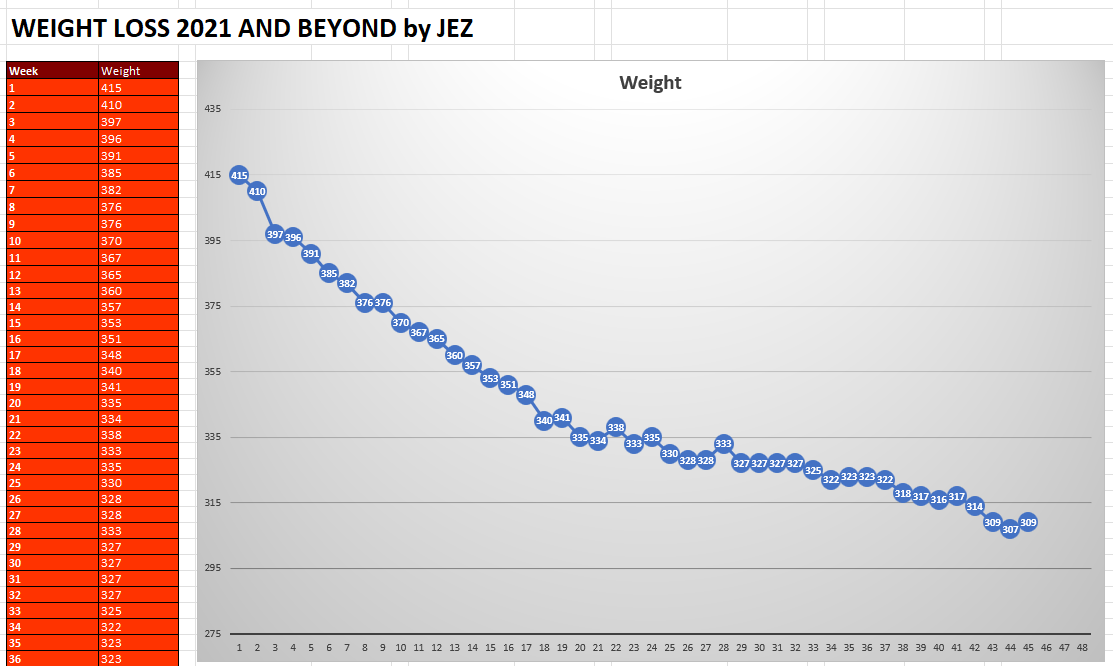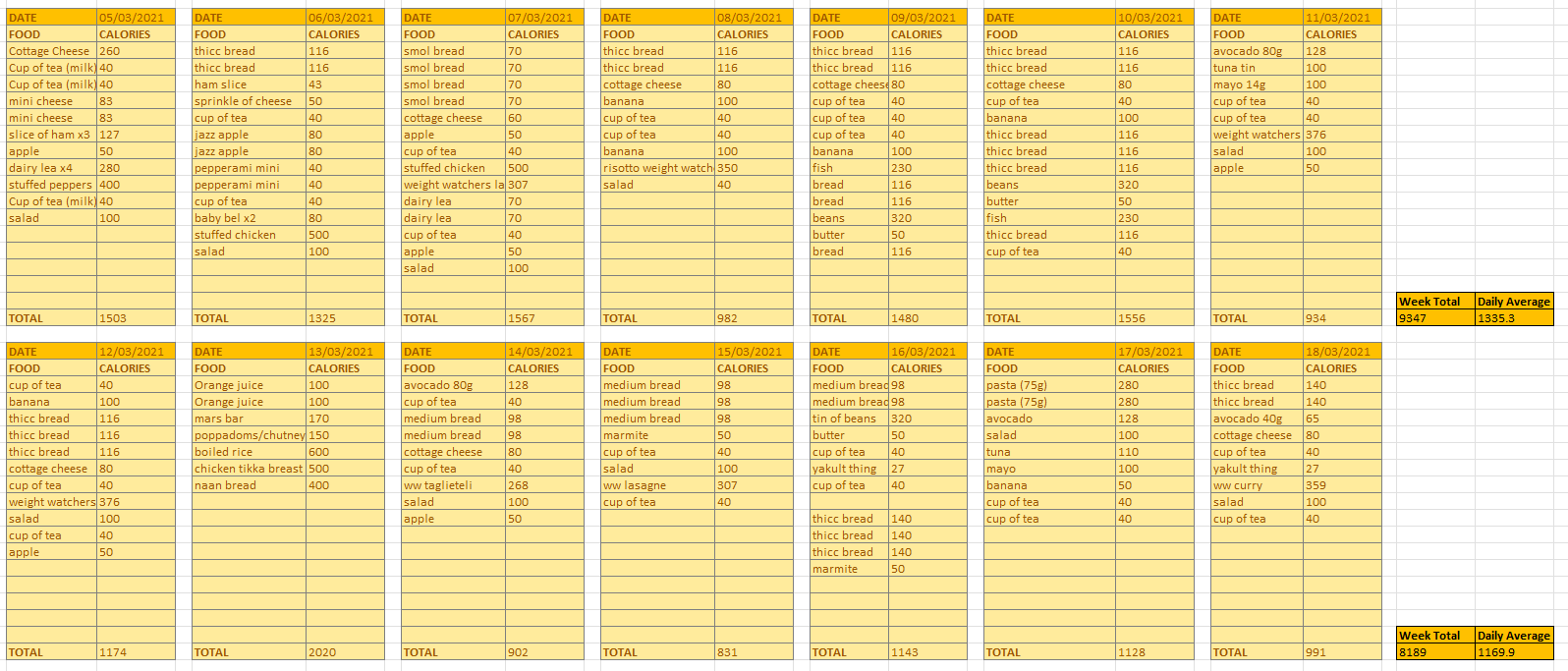I lost over 100 pounds with this simple Microsoft Excel spreadsheet
Microsoft Office to the rescue.


This will be a bit of a personal article, so if that's not your bag, feel free to skip over. However, I wanted to share some of my experiences, with the view it might help a few people out here and there. This is how I've lost 100-plus pounds with Microsoft Excel, and a bit of old-fashioned willpower.
I've struggled with my weight for as long as I can remember. As a kid, I just didn't really have the "I feel full" mechanism that other people seem to have, basically eating until I hit a wall of nausea to know whether or not I wasn't hungry anymore. This is something I carried with me through my teens and my adult life, made all the more worse by getting a work-from-home job. Coupled with the pandemic, and disposable income to spend on daily junk food, my weight went all the way up to around 420 pounds (probably higher — it was only when I dropped to 415 pounds that I could find domestic weighing scales that would actually weigh me).
The pandemic has a lot of people re-evaluating their priorities. The data around the world suggests that obese people are more susceptible to getting seriously ill with COVID. Even beyond that, I'd been dealing with a mysterious stomach illness for the past couple of years that made me want to improve my health in general.
So, here's an overview of how I lost 100-plus pounds in around 10 months by simply using Microsoft Excel, and good old calorie counting.
My spreadsheet and weight loss methodology
Essentially, all I've done here is create a range of tables that allow me to input what I've eaten, and roughly how many calories per day, by tallying up all of the calories eaten throughout each day. I've done it on a weekly rolling basis, then created a weekly average at the end of each seven-day block.
I also have a line graph at the top where I log my weight every Saturday for the past year, which offers an overview of my progress as soon as I open up the spreadsheet. The first time I was able to weigh myself was when I'd already dropped to 415 pounds (and when the scales stopped returning an error message for being too heavy). In the beginning, losing weight was incredibly easy, but as you can see from the chart, it dropped down a bit over time as my body got more used to the new diet plan, and the (fairly minimal) exercise I was doing.
Excel has seen me steadily and gradually lose weight over the course of a year, to a point where I'm almost below 300 pounds for the first time in decades.
Since Christmas, I've stopped tracking my food intake so aggressively because I'm trying to build up habits without having to log everything down. Admittedly, for me, it has certainly been a bit more difficult to consistently lose weight without actively counting, so I may go back to counting again this week. Either way, actively counting and measuring helps you figure out where to create a deficit. I find that if I eat around 1,600 calories per day on a weekly rolling average, I will probably maintain my weight. If I want to lose weight, I need to create a deficit that goes below 1,600 calories, which accounts for my relatively sedentary work-from-home lifestyle. I could certainly do more exercise to increase the number of calories I can eat, sure, but this is what works for me, and has worked for me thus far.
All the latest news, reviews, and guides for Windows and Xbox diehards.
I've tried all of the restriction diets like keto and just found that none of them really worked for me. This method allows me to account for "cheat days" like going out for a pizza and drinks with friends, because I can average out the extra calories by eating less the next few days, as I target around 1,200-1,500 daily average for the week. It also helps me target calorie-sparse foods that are filling but contribute fewer calories overall to the average, such as lettuce and salad with a low-calorie dressing for flavor. Simple tactics like switching from bread to low-calorie crackers, or swapping out cheese for tuna on pasta has also helped immensely. What may otherwise seem like small changes do add up, contributing to a big overall difference.
Excel has seen me steadily and gradually lose weight over the course of a year, to a point where I'm almost below 300 pounds for the first time in decades.
The psychology of direct involvement
I've tried a lot of dieting apps like Noom, for example, which encourage you to build habits using psychology. Weirdly, none of these kinds of apps or services has ever worked for me. I think Microsoft Excel works for me because it feels like I created the project, and am fulfilling the project, using my own system and my own data. Excel even has a more granular diet plan template you can use, but it didn't give me the flexibility nor the weekly average tally I wanted to account for social events and cheat days.
There are no doubt technical methods I could use to improve my spreadsheet, like creating a database of food that will do calculations for me. I am most definitely an Excel novice, but I feel like my setup gives me a level of involvement that I feel some apps remove from the process. Calculating calories has been a bit harder in Germany, since their packaging often lists calories per 100 grams, forcing me to do annoying calculations and weigh food out. U.K. packaging more often lists calories per portion, which is far more friendly to this kind of method. Having to make those calculations somehow contributes to the sense of participation, though, in a way I'm not really sure how to explain, even to myself. There's something about building your own plan that existing apps and services don't really account for — at least for me, and my unique mentality around food.
Obviously, everybody will have something unique that works for them. Weight issues and overeating represent complex medical issues that governments and scientists around the world are fighting to understand. The intersection of social and genetic factors can make weight loss difficult to achieve for many, despite how debilitating it can be. I can't express how good it felt to be able to get on a plane without needing a belt extender for the first time in well over a decade. And sure, I still have quite a ways to go, but it's a great feeling to have made this progress. Simple things like getting up the stairs, or standing up in the shower are now pleasant tasks, rather than arduous missions.
If you're struggling with similar issues and would like to give my calorie-counting method a go — you can use my spreadsheet as a base with this blank version. If you don't have Microsoft 365, Excel and Office on the web are free to use via OneDrive.com.

Jez Corden is the Executive Editor at Windows Central, focusing primarily on all things Xbox and gaming. Jez is known for breaking exclusive news and analysis as relates to the Microsoft ecosystem while being powered by tea. Follow on Twitter (X) and tune in to the XB2 Podcast, all about, you guessed it, Xbox!

